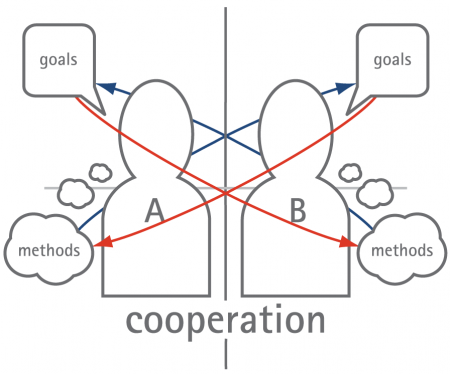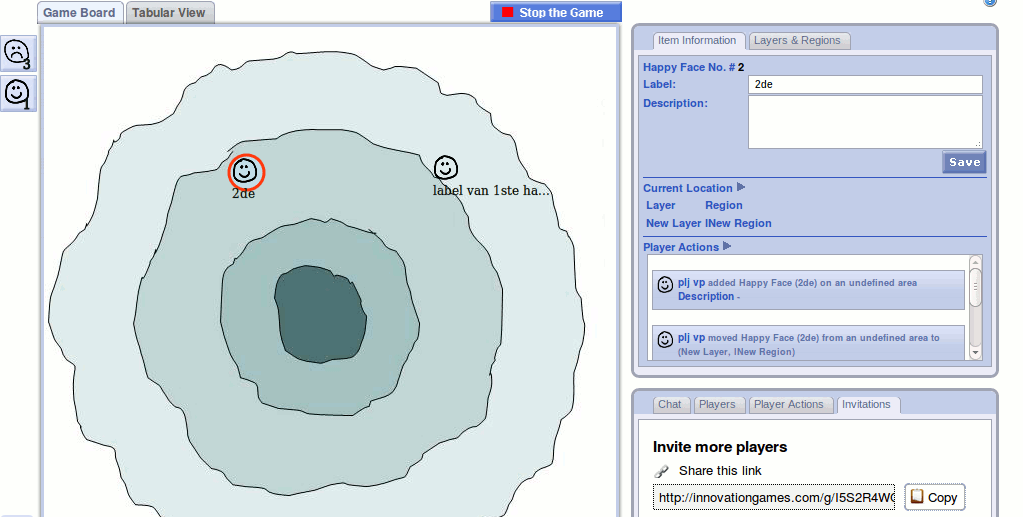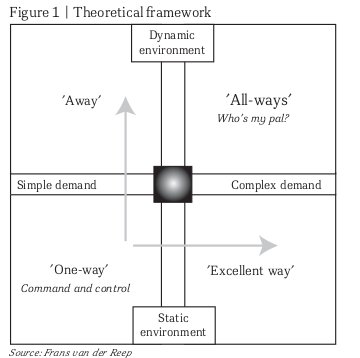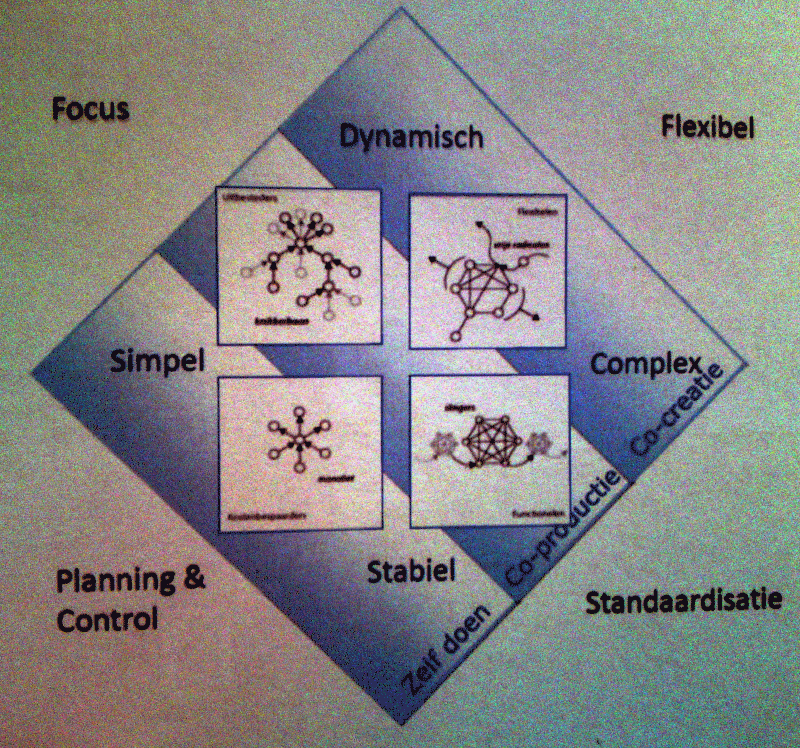Nice visualizations of (competition between) methods and goals when working together. An example of the original post by Fergus Bisset:

Cooperation (cc Fergus Bisset)
research blog supporting instantdebriefing.com
Nice visualizations of (competition between) methods and goals when working together. An example of the original post by Fergus Bisset:

Cooperation (cc Fergus Bisset)
David Burkus explains Survivorship Bias here:
Any time you only examine the successes, you will skew the results.
This is exactly why I like the idea of using a nogari Window desides a johari Window (previous post).
@ innovationgames.com a simple tool for creating visually oriented games, which can be easily shared online. A screenshot of a quick test, using the free version:

You can easily invite your players, by hand and by arranging a ‘party’, so people can subscribe and enter the lobby at a given time.
…if you don’t want to buy / pay for additional services, try building your own with Opa
According to Kanai, Feilden, Firth and Rees (2011)…
… Political orientations are correlated with brain structure in young adults. … Our findings extend previous observations that – high level concepts of – political attitudes reflect differences in self-regulatory conflict monitoring and recognition of emotional faces by showing that such attitudes are reflected in human brain structure.
So, to what extension are we hard wired and sized up with our Anterior Cingulate and Right Amygdyla?
As described in ‘Visualization and how we tick’:
Mengis and Eppler [Seeing versus arguing, the moderating role of collaborative visualization in team knowledge integration, 2006, J. Mengis, M.J. Eppler] state that ‘conversers who interact without an interactive visual support … do not manage to deal constructively with conflict’. They quote Bregman and Haythornthwaite [A. Breman C. Haythornthwaite, Radicals of presentation in persistent conversation, 2001] that concersations are ephemeral, concluding that ‘the major reasons and motivations behind the decisions taken stay often poorly documented’. Mengis and Eppler conclude that thier visualization tool improves decision making, with (a) an increased weight of the constructs ‘Big picture’ and ‘Common ground’ and (b) a decreased weight of the constructs ‘Balanced participation’, ‘Task conflict’ and ‘Relationship conflict’:
… we can say that without an interactive visual support {they} struggle more to integrate their knowledge: they lack common ground and the big picture in the conversation and therefore give more importance to equal participation and conflict.
They also state that interactive, realtime visualization makes conversers taking content criticism less personally.
There are two differences. First, the research of Mengis and Eppler focusses on visualizing content, and not visualizing behavior (like DiMicco and myself). My hypothesis concerns the use of visualization to make (individuals in) groups more assertive, minimizing misdirected energy and maximizing the effectiveness. With a focus on cognitive reframing and multiple attitudes.
The linking pin is a set of recommendations by Amason and Schweiger (1997), as quoted by Kurtz and Snowden in a context of openness and mutuality:
Kurtz and Snowden: … {the} observation that groups which maximise cognitive conflict and minimise affective conflict create an atmosphere of openness and mutuality. Each of these qualities is well known to be supported by narrative exchange, and as such can be augmented using narrative techniques.
Amason and Schweiger: … to the extent that cognitive conflict can be encouraged while affective conflict is restrained, top management teams may be able to “gain the benefits of conflict without the costs” (Eisenhardt & Zbaracki, 1992: 34)
The question is how we can use visualization to overcome our nature: multiple attidutes and rationalization as part of cognitive bias. Here’s an explanation by Amason and Sapienzea (2011):
Cognitive conflict is task-oriented disagreement arising from differences in perspective.
Affective conflict is individual-oriented disagreement arising from personal disaffection.
Bresciani, Tan and Eppler (2011) add the following, in a way suggesting more bling without graphical disturbance:
We propose a model … where visualization has a positive effect on the emotional response of the user that in turn has a positive impact on the cognitive response.
Instead of the more or less temptational approach of Brescani, Tan and Eppler, I suggest to use visualization with an approach of Operant conditioning.
Second, instead of using one context (a company that needs decisions on her project portfolio), I propose a multiple context (many companies that need to find out potential matches towards a not yet shared portfolio of activities). In this case the question ‘why and what’s in it for me and my organizational backbone’ is very much present. It is a more behavioral approach focussing on cognitive reframing and multiple attitudes. And less about transfer of the knowledge.
I am impressed with the unique work of Eppler et al. I’m xpecting to see and learn more, driven by questions as: why exactly do Epplers visualizions do what they need to do? There is more to study regarding regarding visual sallency and best practices.
Regarding my previous research posts, I suggest 3 main solution areas lie ahead: (a) cognitive reframing, (b) multiple attitudes and (c) visual sallience (aka sallency). Let’s make sure we don’t have a ‘Confirmation bias on our hands’.
Our context remains decision making in complex situations, with a focus on visualizing the understanding of relationships, making decision making more effective. I have been looking for disturbance, but it seems we have enough grounds for and types of disturbance (100+ cognitive biases). The trick will be to choose or design an appropriate type of visual feedback -probably related to visual salience- so we can tune the aspects of cognitive reframing and multiple attitudes.
Some preliminary definitions, yet without solid scientific references:
Cognitive restructuring {reframing} in cognitive therapy is the process of learning to refute cognitive distortions, or fundamental “faulty thinking,” with the goal of replacing one’s irrational, counter-factual beliefs with more accurate and beneficial ones.
An Attitude is a mental and neural state of readiness, organized through experience, exerting a directive or dynamic influence upon the individual’s response to all objects and situations with which it is related (Allport, 1935)
The salience (also called saliency) of an item – be it an object, a person, a pixel, etc – is the state or quality by which it stands out relative to its neighbours. Saliency detection is considered to be a key attentional mechanism that facilitates learning and survival by enabling organisms to focus their limited perceptual and cognitive resources on the most pertinent subset of the available sensory data. {this article (Computational modelling of visual attention, 2001, Itti and Koch) and its sources will help defining visual salience}
Let us not forget our context of differentiation over place, time and decision making unit. Nor our emergent understanding about shifting loyalties and their competitiveness.
In his research on cultural differentiation in multi-agent simulations, Verwaart (2011) concludes that an expert system approach is feasible for modeling these differentiations. Cultural differences as defined by Hofstede (2001) and the trust and tracing game (Meijer, 2009) set the base line. The cultural differences are dimensions of private-professional relations, hierarchy impact, cooperation-competition preference, xenophobia and virtues. The game is about explaining the impact of cultural intertwining differences in relatively simple context, with a focus on individual efficiency.
The field of application is a field area of outsourcing, and not an area of ‘free radicals’ and ‘functionals’, like my fields of interest. See the model of Van der Reep (2006) for the differences:

My basic interpretation of this model -of which I cannot find scientific evidence (yet)- is as follows:
| OUTSOURCERS | FREE RADICALS |
| MONOLITHS | FUNCTIONALS |

Further development on this model is done by Van Leeuwen (dutch: waardekompas, 2006), focussing on the necessary roles and relations in teamwork, within the context of strategy developments.
Focussing on a dynamic environment and simple demand, Verwaart validates his expert system approach using:
He is also aloof regarding the conclusions:
A problematic issue is, that similarity of the outputs of gaming simulations and multi-agent simulations is no sound proof that the agent correctly implements the human decision making mechanism. This issue is known as under-determination. A validation method is proposed, which builds on the model’s composed structure. Under-determination can be avoided by separate validation of the components in micro-games.
All in all, the two most interesting aspects -to me- are that:
According to wikipedia cognitive bias is:
…a pattern of deviation in judgment that occurs in particular situations. Implicit in the concept of a “pattern of deviation” is a standard of comparison; this may be the judgment of people outside those particular situations, or may be a set of independently verifiable facts. … a general term that is used to describe many observer effects in the human mind, some of which can lead to perceptual distortion, inaccurate judgment, or illogical interpretation.
Wiki provides a list of the more commonly studied cognitive biases:
- Framing by using a too-narrow approach and description of the situation or issue.
- Hindsight bias, sometimes called the “I-knew-it-all-along” effect, is the inclination to see past events as being predictable.
- Fundamental attribution error is the tendency for people to over-emphasize personality-based explanations for behaviors observed in others while under-emphasizing the role and power of situational influences on the same behavior.
- Confirmation bias is the tendency to search for or interpret information in a way that confirms one’s preconceptions; this is related to the concept of cognitive dissonance.
- Self-serving bias is the tendency to claim more responsibility for successes than failures. It may also manifest itself as a tendency for people to evaluate ambiguous information in a way beneficial to their interests.
- Belief bias is when one’s evaluation of the logical strength of an argument is biased by their belief in the truth or falsity of the conclusion.
A more complete list of cognitive biases provides about 100 differrent cognitive biases, in 4 categories:
It seems humans have developed quite a number of skills in order to cloak their behavior or motives, and also mislead themselves. What if we try and uncloak group individual attitudes as part of effective group behavior in the midst of complexity?
Wilson, Lindey and Schooler’s article ‘a model of dual attitudes‘ (2000) concerns how a new attitude can arise, while the old attitude is not replaced, remaining in memory.
They complete a line of attitude-research:
… when an initial attidue is strong, it biases the processing of new information in an attitude-congruent direction
They split impicit and explicit attitudes, where implicite attitudes are described as unknown origin, activated automatically and influence uncontrollable responses. It seems people are unaware of the origin of these attitudes (thus their evaluation), but not of the attitudes itselves.
Wilson et al. describe 4 types of dual attitudes:
Other dimensions of attitudes, besides dual attitudes are:
The writers also label their 4 types to different literatures relevant to their model: human motivation, attachment, dependency needs, attribution style, prejudice and stereotyping, affective perseverance, attitudes towards relationships, dissonance.
They also suggest that people can have more than two attitudes, a multiple attitude system. Extrapolating from a personal perspective: Regarding to group behavior, within a group their is also a multiple attitude system, where between explicit and implicit attitudes, also a more or less shared attitude duality arises: a multiple attitude system within and between groups.